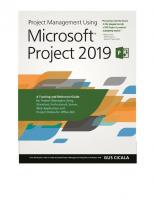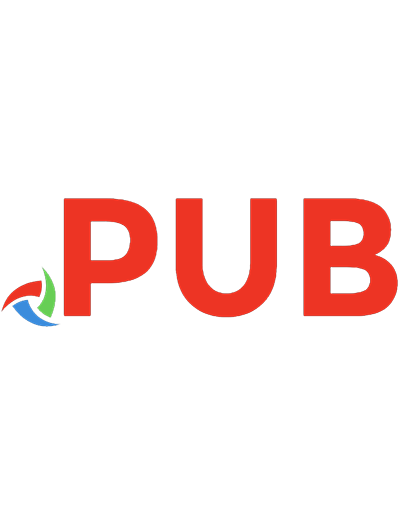Project Based Problem Solving and Decision Making: A Guide for Project Managers [1 ed.] 1394207832, 9781394207831
PROJECT BASED PROBLEM SOLVING AND DECISION MAKING A project manager’s guide to solving complex project issues and making
182 80 10MB
English Pages 208 Year 2023
Table of contents :
Cover Page
Title Page
Copyright Page
Contents
Preface
About the Companion Website
1 Understanding the Concepts
1.0 The Necessity for Problem-Solving and Decision-Making
1.1 Problems and Opportunities
1.2 Research Techniques in the Basic Decision-Making Process
1.3 Facts About Problem-Solving and Decision-Making
1.4 Who Makes the Decision?
1.5 Information Overload
1.6 Getting Access to the Right Information
1.7 The Lack of Information
Discussion Questions
References
2 Understanding the Project Environment and the Impact on Problem Solving
2.0 Understanding the Project Environment
2.1 Project Versus Business Problem-Solving and Decision-Making
2.2 Problem-Solving and Decision-Making in the Project Management Environment
2.3 The Impact of Constraints on Project Problem-Solving and Decision-Making
2.4 The Impact of Assumptions on Project Problem-Solving and Decision-Making
2.5 Understanding the Project Environment’s Complexities
2.6 Selecting the Right Project Manager
2.7 The Impact of the COVID-19 Pandemic on Project Management
Trust
Communications
Decision-Making
Project Control Center
Change Management
Conclusion
2.8 Differences Between Program and Project Problem-Solving and Decision-Making
Reengineering Efforts and Change Management
Career Advancement Opportunities
Data-Driven Risk Management
Stakeholder Relations Management
Multi-Project Management and Innovation
2.9 Problem-Solving in Matrix Management Organizational Structures
Understand Matrix Management
Matrix Structure Challenges
Competing Cultures
Executive Involvement
Team Members
2.10 The Impact of Methodologies on Problem-Solving
Understanding Methodologies
The Faulty Conclusion
The Project Management Landscape Changes
Selecting the Right Framework
Be Careful What You Wish For
2.11 The Need for Problem-Solving Procedural Documentation
Procedural Documentation and Methodologies
Challenges
How To Make It Work
Effective Project Control Practices
References
3 Understanding the Problem
3.0 The Definition of a Problem
3.1 The Time Needed to Identify a Problem
3.2 Not All Problems Can Be Solved
3.3 The Complexities of the Problems
3.4 Techniques for Problem Identification
3.5 Individual Problem-Solving Conducted in Secret
3.6 Team Problem-Solving Conducted in Secret
3.7 Decisions That Can Convert Failures into Successes
Sensemaking
The Need for New Metrics
Learning from Failure
The Failure of Success
References
4 Data Gathering
4.0 Understanding Data Gathering
4.1 Reasons for Data Gathering
4.2 Data-Gathering Techniques
4.3 Metrics and Early Warning Indicators
4.4 Questions to Ask
4.5 Establishing Structure for Data Gathering, Problem-Solving, and Decision-Making
4.6 Determining the Steps
Discussion Questions
5 Meetings
5.0 Problem Analysis Characteristics
5.1 Real Problems Versus Personality Problems
5.2 Determining Who Should Attend the Problem-Solving Meeting
5.3 Determining Who Should Attend the Decision-Making Meeting
5.4 Creating a Framework for the Meeting
5.5 Setting Limits on Problem-Solving and Decision-Making
5.6 Identifying Boundary Conditions
5.7 Understanding How People React in Meetings
5.8 Working with Participants During the Meetings
5.9 Leadership Techniques During Meetings
5.10 Handling Problem-Solving and Decision-Making Conflicts
5.11 Continuous Solutions Versus Enhancement Project Solutions
5.12 Problem-Solving Versus Scope Creep
5.13 Problem-Solving and Decision-Making During Crisis Projects
5.14 Presenting Your Decision to the Customer
Discussion Questions
Reference
6 Developing Alternatives
6.0 Finding Alternatives
6.1 Variables to Consider During Alternative Analyses
6.2 Understanding the Features That Are Part of the Alternatives
6.3 Developing Hybrid Alternatives
6.4 Phantom Alternatives
6.5 Tradeoffs
6.6 Common Mistakes When Developing Alternatives
6.7 Decision-Making for Managing Scope Changes on Projects
General Factors Influencing Project Scope Changes
Timing for Problem Identification
Discussion Questions
Reference
7 Problem-Solving Creativity and Innovation
7.0 The Need for Problem-Solving Creativity
7.1 Creativity and Creative Thinking
7.2 Creativity and Innovation Thinking
7.3 Creativity, Innovation, and Value
7.4 Negative Innovation
7.5 Types of Innovation
7.6 Problem-Solving and Decision-Making Attributes That Are Difficult to Learn
7.7 Creativity Roadblocks
Discussion Questions
8 Problem-Solving Tools and Techniques
8.0 Root Cause Analysis
8.1 General Principles of Root Cause Analysis
8.2 Corrective Actions Using Root Cause Analysis
8.3 Root Cause Analysis Techniques
8.4 Brainstorming
8.5 Rules for Brainstorming
8.6 Critical Steps in Brainstorming
8.7 Conducting the Brainstorming Session: The Process
8.8 Conducting the Brainstorming Session: Evaluation
8.9 Brainstorming Sessions: Nominal Group Technique
8.10 Brainstorming Sessions: Group Passing Technique
8.11 Brainstorming Sessions: Team Idea Mapping Method
8.12 Brainstorming Sessions: Electronic Brainstorming
8.13 Brainstorming Sessions: Directed Brainstorming
8.14 Brainstorming Sessions: Individual Brainstorming
8.15 Question Brainstorming
8.16 Reasons for Brainstorming Failure
8.17 Virtual Brainstorming Sessions
Discussion Questions
9 Decision-Making Concepts
9.0 Decision-Making Alternatives
9.1 Decision-Making Characteristics
9.2 Decision-Making Participation
9.3 Understanding How Decisions Are Made
9.4 Cultures and Problem Solving
9.5 Routine Decision-Making
9.6 Adaptive Decision-Making
9.7 Innovative Decision-Making
9.8 Pressured Decision-Making
9.9 Judgmental Decision-Making
9.10 Rational Decision-Making
9.11 Certainty/Uncertainty Decision-Making
9.12 Controllable/Noncontrollable Decision-Making
9.13 Programmed/Nonprogrammed Decision-Making
9.14 Decision-Making Meetings
9.15 Decision-Making Stages
9.16 Decision-Making Steps
9.17 Conflicts in Decision-Making
9.18 Advantages of Group Decision-Making
9.19 Disadvantages of Group Decision-Making
9.20 Rational Versus Intuitive Thinking
9.21 Divergent Versus Convergent Thinking
9.22 The Fear of Decision-Making: Mental Roadblocks
9.23 Decision-Making Personal Biases
9.24 The Danger of Hasty Decisions
9.25 Decision-Making Styles
9.26 The Autocratic Decision-Maker
9.27 The Fearful Decision-Maker
9.28 The Circular Decision-Maker
9.29 The Democratic Decision-Maker
9.30 The Self-Serving Decision-Maker
9.31 Delegation of a Decision-Making Authority
9.32 Choice Elements of Decision-Making
9.33 Decision-Making Challenges
9.34 Examples of Decision-Making Challenges
The Work-Life Balance
Another Form of the Work-Life Balance
Sharing Credit
Rewarding Individuals
The Risks of Excessive Overtime
Challenging Workers
Discussion Questions
References
10 Decision-Making Tools
10.0 Decision-Making Tools in Everyday Life
10.1 Use of Operations Research and Management Science Models
10.2 SWOT Analysis
10.3 Pareto Analysis
10.4 Multiple Criteria Decision Analysis
10.5 Paired Comparison Analysis
10.6 Decision Trees
10.7 Influence Diagrams
10.8 Affinity Diagrams
10.9 Game Theory
10.10 Cost-Benefit Analysis
10.11 Nominal Work Groups
10.12 Delphi Technique
10.13 Other Decision-Making Tools
10.14 Artificial Intelligence
Customer Reaction
Project Management Maturity
Educating Project Managers
Educating Team Members
10.15 Risk Management
Ethics
AI Penetration
Discussion Questions
References
11 Predicting the Impact
11.0 Evaluating the Impact of a Decision
11.1 Creating a Consequence Table
11.2 Performing Impact Analysis
11.3 The Time to Implement a Solution
11.4 The Definitions for Project Success and Failure Are Changing
Historical Perspective
Early Modification to the Triple Constraints
The Use of Primary and Secondary Constraints
From Triple Constraints to Competing Constraints
11.5 Project Decision-Making and Politics
Discussion Questions
12 The Need for Effective or Active Listening Skills
12.0 Active Listening
12.1 Active Listening Body Language and Communications
12.2 Active Listening Barriers Created by the Speaker
12.3 Active Listening Barriers Created by the Listener
12.4 Overcoming Active Listening Barriers
12.5 Techniques for Effective Listening
Discussion Questions
13 Barriers
13.0 The Growth of Barriers
13.1 Lack of Concern for the Workers Barriers
13.2 Legal Barriers
13.3 Project Sponsorship Barriers
13.4 Cost of Implementation Barriers
13.5 Culture Barriers
13.6 Project Management Office (PMO) Barrier
13.7 Conclusion
Discussion Questions
References
Appendix: Using the PMBOK® Guide
Decision-Making and the PMBOK® Guide
Problem-Solving and the PMBOK® Guide
PMBOK® Guide: Integration Management
PMBOK® Guide: Scope Management
PMBOK® Guide: Time Management
PMBOK® Guide: Cost Management
PMBOK® Guide: Quality Management
PMBOK® Guide: Human Resource Management
PMBOK® Guide: Communications Management
PMBOK® Guide: Risk Management
PMBOK® Guide: Procurement Management
PMBOK® Guide: Stakeholder Management
Further Reading
Index
EULA
![Project Based Problem Solving and Decision Making: A Guide for Project Managers [1 ed.]
1394207832, 9781394207831](https://dokumen.pub/img/200x200/project-based-problem-solving-and-decision-making-a-guide-for-project-managers-1nbsped-1394207832-9781394207831-u-8473930.jpg)
![Project Based Problem Solving and Decision Making: A Guide for Project Managers [1 ed.]
1394207832, 9781394207831](https://dokumen.pub/img/200x200/project-based-problem-solving-and-decision-making-a-guide-for-project-managers-1nbsped-1394207832-9781394207831.jpg)



![Project Risk Management : Essential Methods for Project Teams and Decision Makers [1 ed.]
9781118746240, 9781118482438](https://dokumen.pub/img/200x200/project-risk-management-essential-methods-for-project-teams-and-decision-makers-1nbsped-9781118746240-9781118482438.jpg)
![Project Management for Non-Project Managers [1 ed.]
0814417361, 9780814417362](https://dokumen.pub/img/200x200/project-management-for-non-project-managers-1nbsped-0814417361-9780814417362.jpg)

![Real and Relevant : A Guide for Service and Project-Based Learning [2 ed.]
9781475835465, 9781475835458](https://dokumen.pub/img/200x200/real-and-relevant-a-guide-for-service-and-project-based-learning-2nbsped-9781475835465-9781475835458.jpg)
![Gender and Diversity in a Problem and Project Based Learning Environment [1 ed.]
9788792982834, 9788792329844](https://dokumen.pub/img/200x200/gender-and-diversity-in-a-problem-and-project-based-learning-environment-1nbsped-9788792982834-9788792329844.jpg)
![Creative problem solving for managers : developing skills for decision making and innovation [Fifth ed.]
9780429458255, 0429458258, 9781138312364, 1138312363, 9781138312388, 113831238X](https://dokumen.pub/img/200x200/creative-problem-solving-for-managers-developing-skills-for-decision-making-and-innovation-fifthnbsped-9780429458255-0429458258-9781138312364-1138312363-9781138312388-113831238x.jpg)